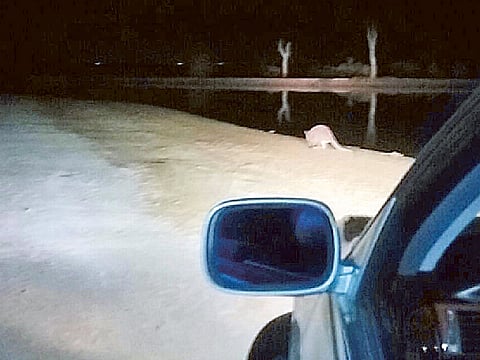Was it a kangaroo? Mystery animal startles UAE campers
Campers say campsite visitor looked like a kangaroo, expert believes it was likely a jerboa

Dubai: Eyewitnesses and a top zoological expert in Dubai are at odds to explain the identity of a mystery animal that appeared out of the darkness at Al Qudra Lake nature preserve on the weekend.
But one thing is for sure.
A mystery animal resembling a wallaby or a very large rodent startled a group of weekend campers shortly before midnight Friday sending shrieking eyewitnesses to the safety of their cars.
“It was dark, we couldn’t see what it was and we were scared. We had girls with us and they were screaming. The eyes were showing and then it hopped toward us,” said Seshan Balasubrananian, 20. “He was staring at us with those eyes for minutes, we couldn’t move because he was coming toward us. It came within two steps of me, that’s when we got in the car.”
Once inside the vehicle, the Dubai student turned his car’s headlights on and took pictures with his smartphone of what appeared to be a kangaroo or its smaller cousin, a wallaby, in front of the car.
Kangaroos and wallabies are found in the wilds of Australia and New Guinea and are not native to the UAE.
“It was a kangaroo, I’m sure. It just looked at our stuff, sniffed it, then went off. It was quite the size when it was standing. It was up to my shoulders and I’m 5’9”,” Balasubrananian told Gulf News. “It looked like the kangaroo came to the lake for a drink of water.”
Camping buddy Huzaifa Khan wasn’t as close to the animal as his friend, but said he believes it was some kind of kangaroo or a smaller wallaby.
“I can’t be sure but it was hopping just like a kangaroo. We were scared and moved back when we saw it,” Khan said. “We didn’t know what it was going to do.”
Dr. Reza Khan, Specialist, Wildlife Management, Public Parks and Horticulture Department with Dubai Municipality, said he couldn’t determine the animal’s identity for certain, but said that judging by the campers’ pictures, he believes the animal is a “small rodent named Lesser Egyptian Jerboa.”
The species is native across North Africa and the Arabian Peninsula to Central Asia, including the UAE, is nocturnal and is often mistaken for a tiny kangaroo because of its long legs that it uses to hop to get around.
Dr Khan told Gulf News that he doubted strongly that it was a wallaby — a smaller cousin of the kangaroo — given that the tail in the pictures he was shown is much longer and that the animal appeared to be foraging at night.
“Wallabies are not nocturnal, they can’t see at night,” Khan said.
The Jerboa on the other hand is “nocturnal and lives in burrows dug by itself. It can aestivate during summer and hibernate during winter.
It is not an uncommon desert animal of the UAE and the larger desert areas in the Arabia,” Dr Khan said, noting that the body “measures up to 11.5cm” and its tail can grow to 25cm.
Campers disagreed with Dr Khan saying the animal they witnessed had a body that was at least 45-50cm long and that its legs and tail were furry unlike the Jerboa. Campers said it was the size of a dog, not a small rodent.
Huzaifa did a search on Google images for wallaby and showed Gulf News one image of a wallaby crouching.
“That was the animal I saw. It was a kangaroo’s face, not a rodent,” he said.
An online search on Monday, however, could not find a single instance of a kangaroo sighting in the wild anywhere in Dubai or the UAE.
Huzaifa suggested the mystery animal may have been a pet at one time and had escaped from its human owners into the wild.
Gulf News has chronicled in recent years a long list of exotic animal sightings such as lions and cheetahs, in recent years — many riding in cars with their owners inside the city — thanks to illegal pet enthusiasts flouting laws that prohibit buying or housing endangered species.
Al Qudra Lake environment, meanwhile, is a nature preserve where more than 100 bird species have been documented by Dr Khan.
The lake is located in the middle of the Seih Al Salam desert and Bab Al Shams and is a man-made project to green the Dubai desert.
“Most [birds spotted in the area] are migratory, barring two dozen species. Al Qudra’s main attraction is its freshwater body covering about 10 hectares where the areas covering it have been planted with fruit trees and trees that give shade,” Dr Khan told Gulf News in an earlier interview.
Sign up for the Daily Briefing
Get the latest news and updates straight to your inbox



